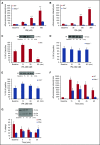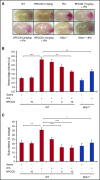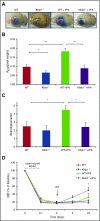Plasma kallikrein mediates brain hemorrhage and edema caused by tissue plasminogen activator therapy in mice after stroke
- PMID: 28130211
- PMCID: PMC5399481
- DOI: 10.1182/blood-2016-09-740670
Plasma kallikrein mediates brain hemorrhage and edema caused by tissue plasminogen activator therapy in mice after stroke
Abstract
Thrombolytic therapy using tissue plasminogen activator (tPA) in acute stroke is associated with increased risks of cerebral hemorrhagic transformation and angioedema. Although plasma kallikrein (PKal) has been implicated in contributing to both hematoma expansion and thrombosis in stroke, its role in the complications associated with the therapeutic use of tPA in stroke is not yet available. We investigated the effects of tPA on plasma prekallikrein (PPK) activation and the role of PKal on cerebral outcomes in a murine thrombotic stroke model treated with tPA. We show that tPA increases PKal activity in vitro in both murine and human plasma, via a factor XII (FXII)-dependent mechanism. Intravenous administration of tPA increased circulating PKal activity in mice. In mice with thrombotic occlusion of the middle cerebral artery, tPA administration increased brain hemorrhage transformation, infarct volume, and edema. These adverse effects of tPA were ameliorated in PPK (Klkb1)-deficient and FXII-deficient mice and in wild-type (WT) mice pretreated with a PKal inhibitor prior to tPA. tPA-induced brain hemisphere reperfusion after photothrombolic middle cerebral artery occlusion was increased in Klkb1-/- mice compared with WT mice. In addition, PKal inhibition reduced matrix metalloproteinase-9 activity in brain following stroke and tPA therapy. These data demonstrate that tPA activates PPK in plasma and PKal inhibition reduces cerebral complications associated with tPA-mediated thrombolysis in stroke.
© 2017 by The American Society of Hematology.
Figures







Comment in
-
Making thrombolysis safer in stroke.Blood. 2017 Apr 20;129(16):2212-2213. doi: 10.1182/blood-2017-02-765610. Blood. 2017. PMID: 28428237 No abstract available.
Similar articles
-
Hydrogen Sulfide Attenuates Tissue Plasminogen Activator-Induced Cerebral Hemorrhage Following Experimental Stroke.Transl Stroke Res. 2016 Jun;7(3):209-19. doi: 10.1007/s12975-016-0459-5. Epub 2016 Mar 28. Transl Stroke Res. 2016. PMID: 27018013
-
Asparagine Endopeptidase Inhibition Attenuates Tissue Plasminogen Activator-Induced Brain Hemorrhagic Transformation After Ischemic Stroke.CNS Neurosci Ther. 2025 Mar;31(3):e70345. doi: 10.1111/cns.70345. CNS Neurosci Ther. 2025. PMID: 40116141 Free PMC article.
-
A Rho kinase (ROCK) inhibitor, fasudil, prevents matrix metalloproteinase-9-related hemorrhagic transformation in mice treated with tissue plasminogen activator.Neuroscience. 2012 Sep 18;220:302-12. doi: 10.1016/j.neuroscience.2012.06.015. Epub 2012 Jun 16. Neuroscience. 2012. PMID: 22710066
-
Select hyperacute complications of ischemic stroke: cerebral edema, hemorrhagic transformation, and orolingual angioedema secondary to intravenous Alteplase.Expert Rev Neurother. 2018 Oct;18(10):749-759. doi: 10.1080/14737175.2018.1521723. Epub 2018 Sep 24. Expert Rev Neurother. 2018. PMID: 30215283 Review.
-
Mechanisms of hemorrhagic transformation after tissue plasminogen activator reperfusion therapy for ischemic stroke.Stroke. 2004 Nov;35(11 Suppl 1):2726-30. doi: 10.1161/01.STR.0000143219.16695.af. Epub 2004 Sep 30. Stroke. 2004. PMID: 15459442 Review.
Cited by
-
Platelets, Thromboinflammation and Neurovascular Disease.Front Immunol. 2022 Mar 4;13:843404. doi: 10.3389/fimmu.2022.843404. eCollection 2022. Front Immunol. 2022. PMID: 35309326 Free PMC article. Review.
-
Impact of Bradykinin Generation During Thrombolysis in Ischemic Stroke.Front Med (Lausanne). 2018 Jul 3;5:195. doi: 10.3389/fmed.2018.00195. eCollection 2018. Front Med (Lausanne). 2018. PMID: 30018956 Free PMC article. Review.
-
The Search for Biomarkers in Hereditary Angioedema.Front Med (Lausanne). 2017 Nov 22;4:206. doi: 10.3389/fmed.2017.00206. eCollection 2017. Front Med (Lausanne). 2017. PMID: 29214154 Free PMC article. Review.
-
Antihypertension effect of astragaloside IV during cerebral ischemia reperfusion in rats.Mol Med Rep. 2023 Jan;27(1):3. doi: 10.3892/mmr.2022.12890. Epub 2022 Nov 4. Mol Med Rep. 2023. PMID: 36331022 Free PMC article.
-
DIA-based technology explores hub pathways and biomarkers of neurological recovery in ischemic stroke after rehabilitation.Front Neurol. 2023 Mar 7;14:1079977. doi: 10.3389/fneur.2023.1079977. eCollection 2023. Front Neurol. 2023. PMID: 36959823 Free PMC article.
References
-
- Hacke W, Kaste M, Bluhmki E, et al. ; ECASS Investigators. Thrombolysis with alteplase 3 to 4.5 hours after acute ischemic stroke. N Engl J Med. 2008;359(13):1317-1329. - PubMed
-
- Hill MD, Lye T, Moss H, et al. . Hemi-orolingual angioedema and ACE inhibition after alteplase treatment of stroke. Neurology. 2003;60(9):1525-1527. - PubMed
-
- Nicole O, Docagne F, Ali C, et al. . The proteolytic activity of tissue-plasminogen activator enhances NMDA receptor-mediated signaling. Nat Med. 2001;7(1):59-64. - PubMed
Publication types
MeSH terms
Substances
Grants and funding
LinkOut - more resources
Full Text Sources
Other Literature Sources
Medical
Molecular Biology Databases
Miscellaneous


